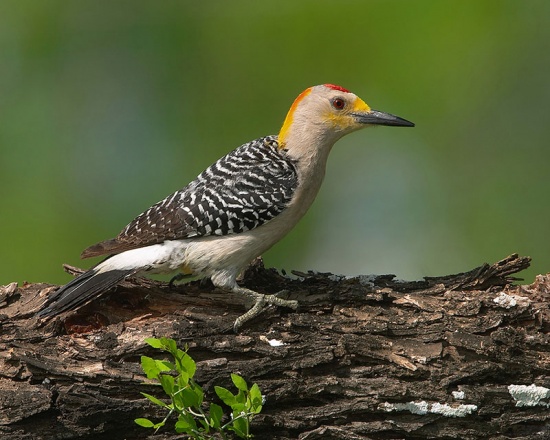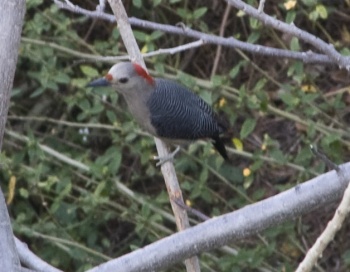- Melanerpes aurifrons
Identification
9 1/2" (24 cm). Barred with black and white above and buff below, nape orange; forecrown yellow; female lacks red on crown, but has orange nape. It is the most commonly observed woodpecker in much of Mexico and northern Central America.
Variation
In southern part of its range the nape is red and not yellow, and in the Yucatan (Mexico) all yellow to golden is replaced by red; in this area, the barring on the back is also finer than in the USA
Similar Species
Red-bellied Woodpecker, which differs in nape color in the area of overlap.
Distribution
Resident from southwestern Oklahoma and central Texas down through Mexico and all of northern Central America to Nicaragua.
Taxonomy
The species name aurifrons is Latin for "gold-fronted" Twelve subspecies occur throughout its range[1]:
- M. a. aurifrons
- M. a. grateloupensis
- M. a. veraecrucis
- M. a. dubius
- M. a. leei
- M. a. turneffensis
- M. a. santacruzi
- M. a. hughlandi
- M. a. pauper
- M. a. insulanus
- M. a. canescens
- M. a. polygrammus
A hybrid zone occurs with the closely related Hoffmann's Woodpecker in southern Honduras. Some authors have suggested that they should be considered as one species. Other authors have suggested treating some of the subspecies as separate species.
Habitat
Open woods in dry country and river bottoms with trees.
This familiar woodpecker is common in the parks and shade trees of central and west Texas towns and cities.
Behaviour
Nesting 4 or 5 white eggs in holes in mesquite trees, poles, and posts.
Voice
Loud churrrr. Call a burry chuck-chuck-chuck.
References
- Clements, JF. 2010. The Clements Checklist of Birds of the World. 6th ed., with updates to December 2010. Ithaca: Cornell Univ. Press. ISBN 978-0801445019. Spreadsheet available at http://www.birds.cornell.edu/clementschecklist/Clements%206.5.xls/view






